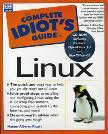

The book's format makes for easy reading, and needed information is easy to locate.

Author: Manuel Alberto Ricart
Publisher: Que, Macmillan Computer Publishing
URL: http://www.mcp.com/
Price: $19.99 US
ISBN: 0-7897-1826-X
Reviewer: Marjorie Richardson
The Complete Idiot's Guide to Linux is yet another book for the newcomer to Linux. The layout of the book is just like others in the Idiot's series, so if you have read one of the others, this one will seem familiar. I've personally never understood why a company would choose to insult their customers by calling them “idiots” or “dummies”, but it seems to work—this is a popular series. I also found the graphics a bit cutesy, but then again, whatever works. The book's format makes for easy reading, and needed information is easy to locate.
This book takes a unique approach by covering the use of Linux with a graphical desktop, namely KDE. This should make Linux seem a bit more palatable to users migrating from Windows or Macintosh environments. It is advertised as being for the beginning to intermediate user—I'd say just the beginning user. The information is good, but so basic the intermediate user will already know it. An example of one such simplistic bit of information is the statement “icons are buttons too”.
The distribution covered is Caldera OpenLinux v1.3, which is on the CD-ROM included with the book. Installation is relegated to Appendix A, so you read the Appendices first, then move on to Part 1, Chapter 1, which describes the KDE desktop. Installation, in fact everything in the book, is given a step-by-step approach that should be easy even for the complete computer beginner. Information is comprehensive and presented in a clear, concise manner.
The author points out that while KDE looks much like MS Windows and Macintosh desktops, quite a few differences exist. He then goes on to describe KDE, letting you discover the differences on your own. Using KDE certainly makes Linux more accessible to the GUI aficionado. KDE looks good and works well. It provides drop-down menus, buttons, tool bars, dialog boxes—all the things one expects of a good graphical user interface. Reading through Part 1, I kept asking myself, “where's the prompt?” I didn't find out until Chapter 11.
Basic file organization and management through the GUI is fully discussed. Changing file permissions and groups can be done by clicking on a button—no more time spent figuring out the right value to give the chmod command. Instructions are also given for reading and writing files to floppy disk.
Chapter 8 talks about accessing the network. Again, it is done with step-by-step instructions for everything from configuring the modem to setting up dial-up service to your ISP. All forms of communication, e.g., web, e-mail and FTP, are discussed at their most basic levels. After reading these chapters, you will know what these services are and how to use them—exactly what you, as a newbie, need to know.
In Part 2, I finally found my introduction to the shell. Here, the most basic commands, such as cd and ls, are discussed, along with those options considered useful by the author. When discussing file commands, the proper warning about running commands as root is given. The text editors covered are vim and Xemacs.
Part 3 deals with necessary system tasks, including user management and backups. Since the covered system is Caldera, Chapter 21 deals with LISA, the Linux Installation and System Administration utility. There are also chapters on installing applications using the Red Hat Package Manager (jointly developed with Caldera), customizing your kernel using LISA, and configuring Apache. By the time you've learned how to do all the tasks described in these final chapters, you can upgrade your standing from newbie to intermediate.
Mr. Ricart has written a very good book for the newcomer to Linux, giving the reader the basics without going deeply into technical details. He has been working with UNIX for many years and with Linux since 1996. He knows his stuff.